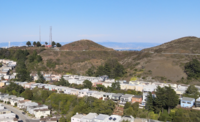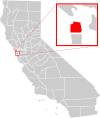Twin Peaks (San Francisco)
| Twin Peaks | |
|---|---|
 The Twin Peaks | |
 | |
| Type | Municipal (San Francisco) |
| Location | San Francisco |
| Area | 34 acres (14 ha) |
| Operated by | San Francisco Recreation & Parks |
| Status | Open all year |
| Highest point | |
| Elevation | 925 ft (282 m) NAVD 88[1] |
| Listing | San Francisco Hill |
| Coordinates | 37°45′06″N 122°26′52″W / 37.751586275°N 122.447721511°W[2] |
| Geography | |
| Location | San Francisco, California, U.S. |
| Topo map | USGS San Francisco North |
| Climbing | |
| Easiest route | Paved road, hike |
The Twin Peaks are two prominent hills with an elevation of about 925 feet (282 m)[1] located near the geographic center of San Francisco, California. The Twin Peaks are the second and third highest mountains in the city; only 928 foot (283 m) Mount Davidson is higher within San Francisco city limits.[3]
Location and climate[edit]
The North and South Twin Peaks, also known as "Eureka" and "Noe" respectively, are about 660 ft (200 m) apart. The peaks form a divide for the summer coastal fog pushed in from the Pacific Ocean. Their west-facing slopes often get fog and strong winds, while the east-facing slopes receive more sun and warmth.[3] Elevation at each summit is just over 900 feet (270 m). Thin, sandy soil is commonplace on Twin Peaks, making them susceptible to erosion.[3] On some rare occasions, Twin Peaks has been able to get a dusting of snow especially on February 5, 1976, when it got several inches of snow. Most recently on February 26, 2011, and February 5, 2019, Twin Peaks got a few flurries of snowflakes.[citation needed]
History[edit]

Early history[edit]
Before the arrival of the Europeans, the native Ohlone people may have used Twin Peaks as a lookout or hunting ground.[4]
18th and 19th centuries[edit]
When the Spanish conquistadors and settlers arrived at the beginning of the 18th century, they called the area "Los Pechos de la Chola" or "Breasts of the Indian Maiden" and devoted the area to ranching.[4] When San Francisco passed under American control during the 19th century, it was renamed "Twin Peaks".
21st century[edit]
In 2016 the SFMTA introduced a traffic calming pilot to reduce the amount of space allocated to cars and make the summit area more inviting to a wider range of travel modes. The "figure of 8" roadway around the two peaks was reduced to a two-way road on the western side of the peaks, with the east side designated for pedestrians and bikes only.

Attractions[edit]
Christmas Tree Point lies some 70 ft (20 m) below the North Peak and offers vistas of San Francisco and San Francisco Bay.[3][5] The view to the north extends no farther than Cobb Mountain (38°48′25″N 122°44′28″W / 38.807°N 122.741°W) 120 km (75 mi) away, but looking southeast down the Santa Clara Valley on a clear day, Santa Ana Mountain 36°52′42″N 121°15′49″W / 36.8782°N 121.2637°W is just visible 143 km (89 mi) away.
To the north is one of the city's many reservoirs. It is owned by the San Francisco Fire Department, and supplies water to the Fire Department's independent HPFS water system for fighting fires, established after the 1906 earthquake and fire.[6]
The top of Twin Peaks is undeveloped. It is part of the 31 acres (13 ha) Twin Peaks Natural Area,[7] managed and owned by the San Francisco Recreation and Parks Department.[3] These preserved areas are home to many natural resources and wildlife. As part of the Mission blue butterfly habitat conservation, Twin Peaks is one of the few remaining habitats for this endangered species. Many bird species, insects and vegetation thrive in these areas.[3]
The Muni Metro Twin Peaks Tunnel runs beneath Twin Peaks, linking downtown San Francisco with West Portal and the southwestern part of the city.[8] There is no public transportation all the way to the top of the Peaks, but the 37 Corbett Muni line stops on Crestline Drive near a path up the hill.[9]
The San Francisco Police Department Academy is at the base of the peaks.[10]
The name "Twin Peaks" is also applied to the surrounding neighborhood.
Education[edit]
This section needs expansion. You can help by adding to it. (April 2018) |
The San Francisco Unified School District operates the Ruth Asawa San Francisco School of the Arts in the Twin Peaks neighborhood.[11] The closest SFUSD school to the top of Twin Peaks is Rooftop [1]
See also[edit]
References[edit]
- ^ a b "Twin Peaks, California". Peakbagger.com. Retrieved 2009-02-27.
- ^ "South Twin 2". NGS Data Sheet. National Geodetic Survey, National Oceanic and Atmospheric Administration, United States Department of Commerce.
- ^ a b c d e f San Francisco Recreation and Parks Department (2006). "Twin Peaks" Archived 2007-09-30 at the Wayback Machine, section 6.8 of Significant Natural Resources Areas Management Plan Archived 2008-03-14 at the Wayback Machine. Retrieved April 21, 2007.
- ^ a b http://www.sfgov.org/site/uploadedfiles/recpark/volunteer/Community_Catalyst_Newsletters/brochure_web%281%29.pdf Archived 2011-06-14 at the Wayback Machine sfgov.org
- ^ Kelly, Colleen.Twin Peaks: San Francisco's Best View, sftravel.com.
- ^ Fisher, Leslie. "A Look Back at History: Twin Peaks Reservoir and the City's Emergency Water System". San Francisco Water Power Sewer. San Francisco Public Utilities Commission. Retrieved 19 March 2022.
- ^ Southeastern Natural Areas, Natural Area Program, San Francisco Recreation & Park.
- ^ Menzies, Jeremy. "Twin Peaks Tunnel: A Portal to the West". SFMTA.com. San Francisco Municipal Transportation Agency. Retrieved 19 March 2022.
- ^ "37 Corbett". SFMTA.com. San Francisco Municipal Transportation Agency. Retrieved 19 March 2022.
- ^ "SFPD Academy". SFgov.org. City and County of San Francisco. Retrieved 19 March 2022.
- ^ "Location." Ruth Asawa San Francisco School of the Arts. Retrieved on April 19, 2018. "We are located in the city's Twin Peaks neighborhood."
External links[edit]
- Coffey, Geoffrey (March 27, 2004). "Treasures in the curves and swells of Twin Peaks". San Francisco Chronicle.



